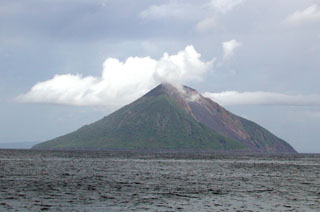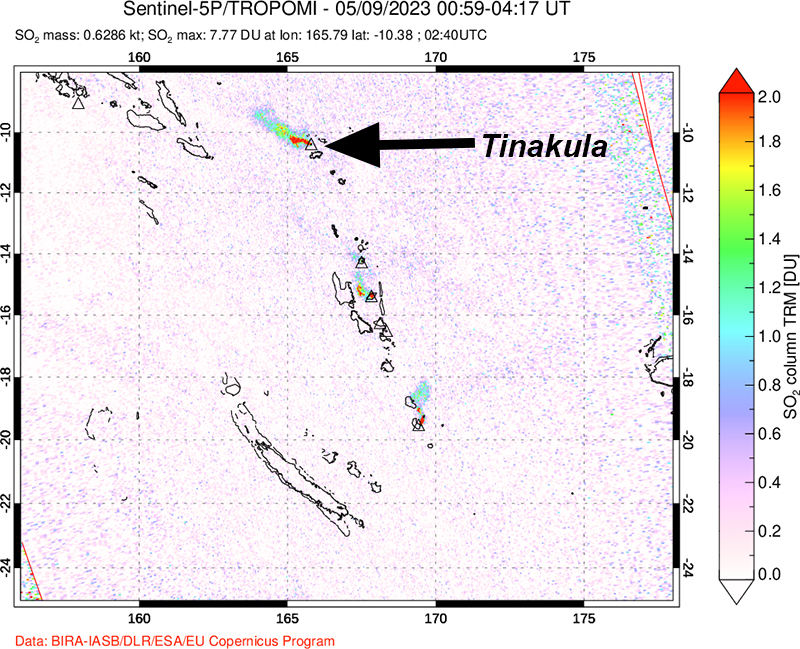Report on Tinakula (Solomon Islands) — June 2023
Bulletin of the Global Volcanism Network, vol. 48, no. 6 (June 2023)
Managing Editor: Kadie Bennis.
Edited by Edward A. Venzke.
Tinakula (Solomon Islands) Ongoing intermittent lava flows and thermal anomalies during October 2022-May 2023
Please cite this report as:
Global Volcanism Program, 2023. Report on Tinakula (Solomon Islands) (Venzke, E.A., and Bennis, K.L., eds.). Bulletin of the Global Volcanism Network, 48:6. Smithsonian Institution.
Tinakula
Solomon Islands
10.386°S, 165.804°E; summit elev. 796 m
All times are local (unless otherwise noted)
Tinakula is a remote 3.5 km-wide island in the Solomon Islands, 640 km ESE of the capital, Honiara. Recent activity of the island’s stratovolcano began with an ash explosion in October 2017, followed in December 2018 by dense gas-and-steam plumes and thermal anomalies from lava flows (BGVN 44:07, 47:02), which continued into 2023. The current report summarizes activity during October 2022-May 2023 using satellite data.
When the weather was clear Sentinel-2 satellite imagery showed lava flows and persistent white gas-and-steam plumes rising from the crater during October 2022-May 2023. Infrared MODIS satellite data processed by MIROVA (Middle InfraRed Observation of Volcanic Activity) detected intermittent low-power hotspots during the reporting period, but more frequent and intense anomalies during late April 2023 due to lava flows on the NW flank.
Imagery on 13 October 2022 showed a narrow lava flow on the NW flank reaching the ocean. The flow appeared larger in infrared images when visible on 23 October and 12 November (figure 52). Although small thermal anomalies were present in the summit area, no significant activity was detected through mid-April 2023. On 26 April another lava flow (figure 52), larger than the previous October-November, again reached the ocean, consistent with the more intense MODIS data. Several strong sulfur dioxide emissions were recorded by the TROPOMI instrument on the Sentinel-5P satellite between 28 April-19 May 2023, the most prominent one on 9 May (figure 52).
Geological Summary. The small 3.5-km-wide island of Tinakula is the exposed summit of a massive stratovolcano at the NW end of the Santa Cruz islands. It has a breached summit crater that extends from the summit to below sea level. Landslides enlarged this scarp in 1965, creating an embayment on the NW coast. The Mendana cone is located on the SE side. The dominantly andesitic volcano has frequently been observed in eruption since the era of Spanish exploration began in 1595. In about 1840, an explosive eruption apparently produced pyroclastic flows that swept all sides of the island, killing its inhabitants. Recorded eruptions have frequently originated from a cone constructed within the large breached crater. These have left the upper flanks and the steep apron of lava flows and volcaniclastic debris within the breach unvegetated.
Information Contacts: Sentinel Hub Playground (URL: https://www.sentinel-hub.com/explore/sentinel-playground); MIROVA (Middle InfraRed Observation of Volcanic Activity), a collaborative project between the Universities of Turin and Florence (Italy) supported by the Centre for Volcanic Risk of the Italian Civil Protection Department (URL: http://www.mirovaweb.it/); NASA Global Sulfur Dioxide Monitoring Page, Atmospheric Chemistry and Dynamics Laboratory, NASA Goddard Space Flight Center (NASA/GSFC), 8800 Greenbelt Road, Goddard, Maryland, USA (URL: https://so2.gsfc.nasa.gov/).



